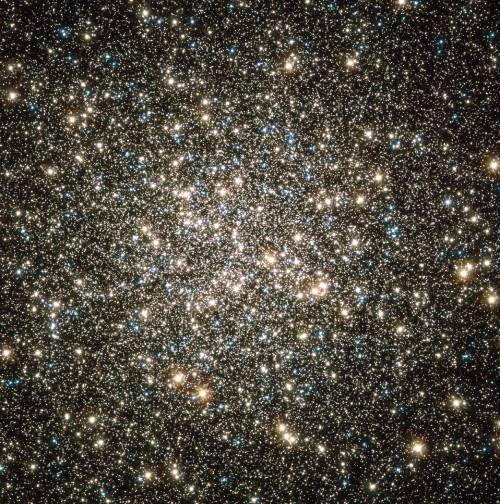Messier 13 (M13), also known as the Great Globular Cluster in Hercules, is one of the most renowned and impressive globular clusters visible in the night sky. It is situated at a distance of approximately 22,200 light-years from Earth.
M13 was first discovered by the astronomer Edmond Halley in 1714, and it was later catalogued by Charles Messier as the 13th entry in his famous catalogue of non-cometary celestial objects in 1764. Here are more details about this stunning celestial object:
Composition
M13 is a globular cluster, characterized by its densely packed spherical collection of hundreds of thousands to millions of stars bound together by gravity. The stars within M13 are predominantly older and cooler, appearing as redder stars due to their lower temperatures. However, the cluster also contains some brighter, hotter blue stars scattered throughout, providing a beautiful contrast against the overall reddish hue. The cluster spans approximately 145 light-years in diameter, making it one of the largest globular clusters in our galaxy.
The density of stars in M13 is particularly remarkable, with the central regions exhibiting a core that is exceptionally crowded with stars. This high stellar density creates an intricate stellar environment where gravitational interactions play a significant role in the cluster’s dynamics. The composition of M13 also includes a mix of main-sequence stars, red giants, and possibly remnants of supernovae, offering insight into the life cycles of stars and the processes that govern stellar evolution.
Observation
The Great Globular Cluster has a visual magnitude of approximately 5.8, making it just visible to the naked eye under dark skies and easily observable with binoculars or a small telescope. For observers in the Northern Hemisphere, it is best viewed during the late spring, summer, and early autumn months, typically from May through September. During this period, the constellation Hercules, in which M13 is located, is high in the sky and most easily visible.

Observing M13 is ideal when the weather is clear and the nights are dark. It’s important to check the phase of the Moon, as bright moonlight can interfere with the visibility of fainter objects like M13. Utilizing binoculars or a telescope significantly enhances the experience, allowing observers to resolve individual stars within the cluster.
When viewed through 10×50 or 15×70 binoculars, M13 generally appears as a bright, fuzzy patch of light. However, when observed through a telescope, it reveals a stunning array of individual stars. The core of the cluster is particularly dense, with stars closely packed together, creating a dazzling display of light.
Observing the Great Globular Cluster is a rewarding experience for amateur astronomers and is often regarded as one of the most beautiful objects in the night sky. It is relatively easy to locate, positioned between the bright stars Eta and Zeta Herculis in the constellation Hercules. This accessibility, combined with its striking appearance, makes M13 a must-see for anyone interested in exploring the wonders of the universe.



